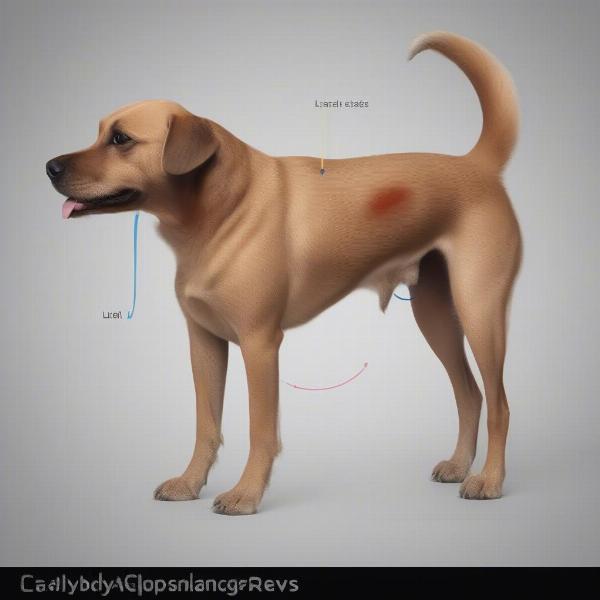Dog bleeding after glands expressed can be alarming for any owner. While a small amount of blood isn’t always a cause for panic, it’s crucial to understand why it happens and when it signals a potential problem. This article delves into the reasons behind bleeding after anal gland expression, when to seek veterinary attention, and how to provide appropriate care for your furry friend.
Understanding Anal Gland Expression and Potential Bleeding
Anal glands, located on either side of your dog’s anus, contain a foul-smelling fluid that naturally expresses during defecation. Sometimes, these glands can become impacted or infected, requiring manual expression. While this procedure is usually straightforward, bleeding can occasionally occur. This is often due to the pressure applied during expression, especially if the glands are inflamed or infected.
When is Bleeding a Cause for Concern?
A tiny spot of blood after anal gland expression is usually not a significant concern. However, if you notice a significant amount of bright red blood, prolonged bleeding, or blood mixed with pus, it’s crucial to consult your veterinarian immediately. This could indicate a more serious underlying issue like an infection, abscess, or even a ruptured anal gland.
Common Causes of Bleeding After Anal Gland Expression
Several factors can contribute to bleeding after anal gland expression:
- Inflammation: Inflamed anal glands are more prone to bleeding during expression due to increased fragility of the surrounding tissues.
- Infection: Infected glands can lead to abscess formation, increasing the risk of bleeding and requiring veterinary intervention.
- Improper Technique: Incorrect expression techniques, especially excessive pressure, can damage the delicate tissues and cause bleeding.
- Underlying Health Conditions: Certain medical conditions, like anal gland tumors, although rare, can make bleeding more likely.
What to Do if Your Dog is Bleeding After Gland Expression
If your dog experiences bleeding after their anal glands are expressed, closely monitor the area. If the bleeding is minimal and stops quickly, clean the area gently with warm water and a soft cloth. However, if the bleeding is heavy, persistent, or accompanied by other symptoms like swelling, pain, or lethargy, contact your veterinarian without delay.
Preventing Anal Gland Problems and Bleeding
While not all anal gland issues can be prevented, a few strategies can help:
- High-Fiber Diet: A diet rich in fiber can help bulk up your dog’s stool, promoting natural expression of the anal glands during defecation.
- Regular Exercise: Regular physical activity helps maintain healthy bowel movements, which can contribute to regular anal gland emptying.
- Veterinary Checkups: Regular veterinary checkups allow for early detection and management of any potential anal gland problems.
 Healthy Dog Anal Glands
Healthy Dog Anal Glands
Conclusion
While a small amount of dog bleeding after glands expressed can be normal, excessive or persistent bleeding warrants veterinary attention. Understanding the potential causes, monitoring your dog closely, and seeking professional advice when necessary will help ensure your furry companion’s anal gland health. Don’t hesitate to contact your veterinarian if you have any concerns about your dog’s anal glands.
FAQ
- How often should a dog’s anal glands be expressed? Most dogs never require manual expression. However, if needed, it’s usually only done when problems arise.
- Can I express my dog’s anal glands at home? It’s best to leave anal gland expression to a veterinarian or a trained professional. Improper technique can cause injury and discomfort.
- What are the signs of impacted anal glands? Signs include scooting, excessive licking of the anal area, and a foul fishy odor.
- Is anal gland removal an option? While possible, anal gland removal is typically reserved for chronic or severe cases.
- What can I feed my dog to help with anal gland issues? A high-fiber diet can promote healthy bowel movements, which can aid in natural anal gland expression.
- Are certain breeds more prone to anal gland problems? Smaller breeds tend to be more susceptible to anal gland issues.
- Can anal gland problems be painful for dogs? Yes, impacted or infected anal glands can be very uncomfortable and even painful for dogs.
Related Articles
About ILM Dog
ILM Dog (https://ilmdog.com) is your trusted international resource for comprehensive dog care and breeding information. We provide expert advice on dog breeds, health, training, nutrition, grooming, and much more. Our mission is to empower dog owners worldwide with the knowledge and resources they need to ensure their canine companions thrive. For personalized guidance or further assistance, contact us via email at [email protected] or phone at +44 20-3965-8624.